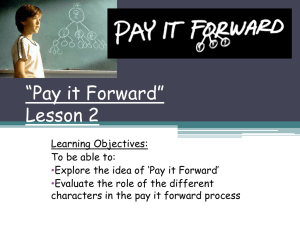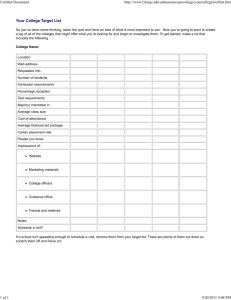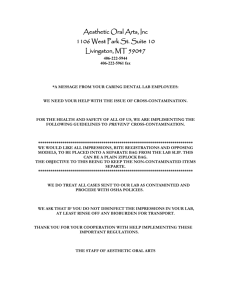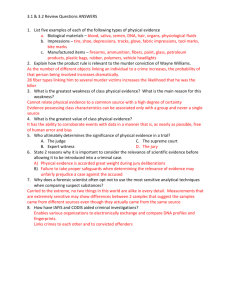ELA 30-1 Personal Response toText rubric
advertisement
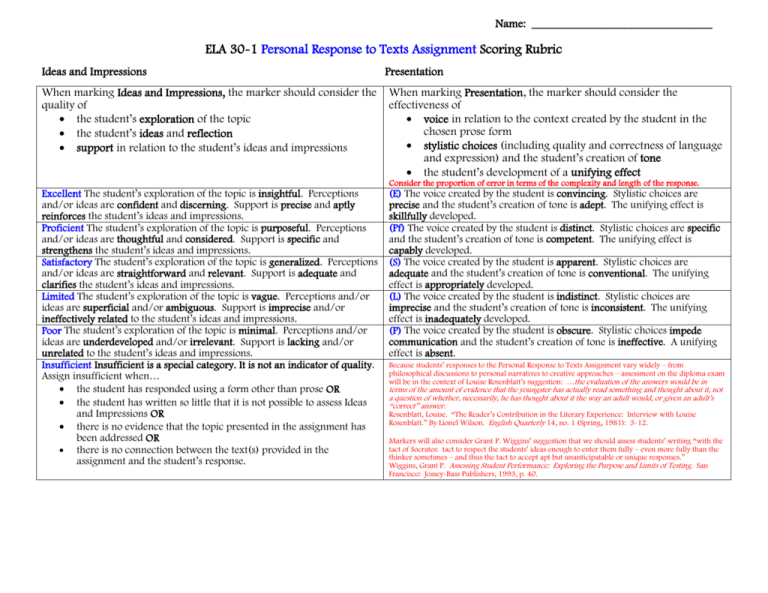
Name: _______________________________ ELA 30-1 Personal Response to Texts Assignment Scoring Rubric Ideas and Impressions When marking Ideas and Impressions, the marker should consider the quality of the student’s exploration of the topic the student’s ideas and reflection support in relation to the student’s ideas and impressions Presentation When marking Presentation, the marker should consider the effectiveness of voice in relation to the context created by the student in the chosen prose form stylistic choices (including quality and correctness of language and expression) and the student’s creation of tone the student’s development of a unifying effect Consider the proportion of error in terms of the complexity and length of the response. Excellent The student’s exploration of the topic is insightful. Perceptions and/or ideas are confident and discerning. Support is precise and aptly reinforces the student’s ideas and impressions. Proficient The student’s exploration of the topic is purposeful. Perceptions and/or ideas are thoughtful and considered. Support is specific and strengthens the student’s ideas and impressions. Satisfactory The student’s exploration of the topic is generalized. Perceptions and/or ideas are straightforward and relevant. Support is adequate and clarifies the student’s ideas and impressions. Limited The student’s exploration of the topic is vague. Perceptions and/or ideas are superficial and/or ambiguous. Support is imprecise and/or ineffectively related to the student’s ideas and impressions. Poor The student’s exploration of the topic is minimal. Perceptions and/or ideas are underdeveloped and/or irrelevant. Support is lacking and/or unrelated to the student’s ideas and impressions. Insufficient Insufficient is a special category. It is not an indicator of quality. Assign insufficient when… the student has responded using a form other than prose OR the student has written so little that it is not possible to assess Ideas and Impressions OR there is no evidence that the topic presented in the assignment has been addressed OR there is no connection between the text(s) provided in the assignment and the student’s response. (E) The voice created by the student is convincing. Stylistic choices are precise and the student’s creation of tone is adept. The unifying effect is skillfully developed. (Pf) The voice created by the student is distinct. Stylistic choices are specific and the student’s creation of tone is competent. The unifying effect is capably developed. (S) The voice created by the student is apparent. Stylistic choices are adequate and the student’s creation of tone is conventional. The unifying effect is appropriately developed. (L) The voice created by the student is indistinct. Stylistic choices are imprecise and the student’s creation of tone is inconsistent. The unifying effect is inadequately developed. (P) The voice created by the student is obscure. Stylistic choices impede communication and the student’s creation of tone is ineffective. A unifying effect is absent. Because students’ responses to the Personal Response to Texts Assignment vary widely – from philosophical discussions to personal narratives to creative approaches – assessment on the diploma exam will be in the context of Louise Rosenblatt’s suggestion: …the evaluation of the answers would be in terms of the amount of evidence that the youngster has actually read something and thought about it, not a question of whether, necessarily, he has thought about it the way an adult would, or given an adult’s “correct” answer. Rosenblatt, Louise. “The Reader’s Contribution in the Literary Experience: Interview with Louise Rosenblatt.” By Lionel Wilson. English Quarterly 14, no. 1 (Spring, 1981): 3-12. Markers will also consider Grant P. Wiggins’ suggestion that we should assess students’ writing “with the tact of Socrates: tact to respect the students’ ideas enough to enter them fully – even more fully than the thinker sometimes – and thus the tact to accept apt but unanticipatable or unique responses.” Wiggins, Grant P. Assessing Student Performance: Exploring the Purpose and Limits of Testing. San Francisco: Jossey-Bass Publishers, 1993, p. 40.

